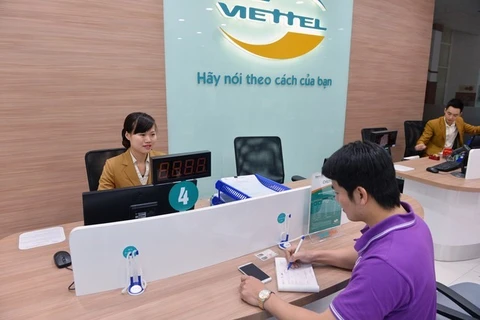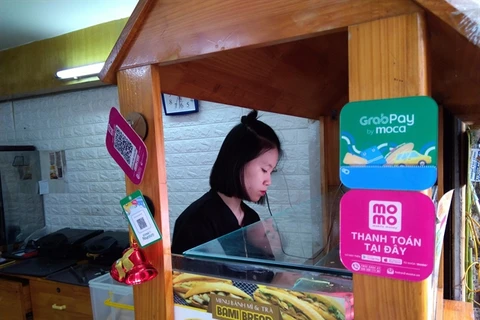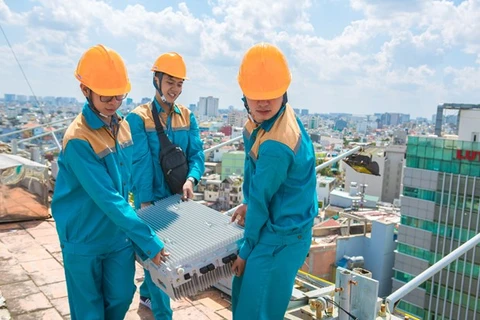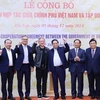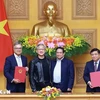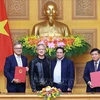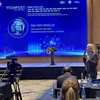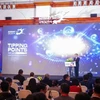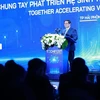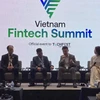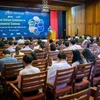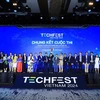Hanoi (VNS/VNA) - Telecommunications firms are turning towards developing their own digital content, the Vietnam Telecommunications Authority (VNTA) under the Ministry of Information and Communications has said.
Mobile service revenue is mainly based on traditional telecommunication services, with revenue from voice calls and SMS messages accounting for 76.6 percent.
With tightened management over pre-activated SIM cards, the number of mobile phone subscriptions was 125.8 million last year, a year-on-year decrease of 3.5 percent.
However, the number of broadband subscribers has increased significantly, with mobile broadband (3G, 4G) having 61.3 million subscriptions, accounting for 48.7 percent of the total number of mobile subscriptions.
The total market share of the three largest enterprises, Vinaphone, MobiFone, and Viettel, accounted for more than 96.2 percent last year, said VNTA.
Commenting on the telecommunications market, Huynh Quang Liem, deputy general director of Vinaphone's VNPT said traditional telecommunications services were declining.
Specifically, the use of voice call services decreased by 18 percent last year, while data service use tripled.
Deputy Minister of Information and Communications Pham Hong Hai said global trends would affect the country's telecommunications market such as the impact of the Internet of Things (IoT) and cross-border services.
Facing this situation, Vietnamese telecommunication enterprises have shifted to developing digital services.
For example, last year VNPT launched its digital transformation efforts with the 'VNPT 4.0' strategy.
Its digital services grew strongly, as the fintech service with the VNPT Pay application achieved a 60 times increase in cash flow.
Along with that, VNPT made a breakthrough in infrastructure investment for mobile networks, fixed broadband, information technology services and digital services.
Meanwhile, MobiFone has also digitised a lot of internal operations such as e-office, ERP (enterprise resource planning) software and infrastructure.
MobiFone said it would use modern technologies to automate its entire infrastructure as well as customer transaction points.
The country’s digital infrastructure and services have developed strongly since last year, said VNTA.
Revenue from data increased to about 30 percent of total service revenue.
The cloud market has a turnover of about 220 million USD with a growth rate of 40 percent per year.
The Internet economy is estimated to have a size of 12 billion USD with a growth rate of 38 percent annually.
To prepare infrastructure for the digital economy and digital society, and deploy national digital transformation, telecommunications businesses are focusing on promoting the development of important digital infrastructure this year.
First is building a cloud application programme for e-government.
For IoT infrastructure, companies are required to promote the deployment of IoT services on the national mobile telecommunications network to set a foundation for the development of smart agriculture, smart transport and smart cities.
Regarding e-financial infrastructure, VNTA will promote comprehensive finance and non-cash payment by guiding three telecommunications businesses to pilot mobile money services.
Deputy Minister Pham Hong Hai said the Ministry of Information and Communications would study and propose appropriate management methods to promote the sustainable development of the telecommunications market./.
Mobile service revenue is mainly based on traditional telecommunication services, with revenue from voice calls and SMS messages accounting for 76.6 percent.
With tightened management over pre-activated SIM cards, the number of mobile phone subscriptions was 125.8 million last year, a year-on-year decrease of 3.5 percent.
However, the number of broadband subscribers has increased significantly, with mobile broadband (3G, 4G) having 61.3 million subscriptions, accounting for 48.7 percent of the total number of mobile subscriptions.
The total market share of the three largest enterprises, Vinaphone, MobiFone, and Viettel, accounted for more than 96.2 percent last year, said VNTA.
Commenting on the telecommunications market, Huynh Quang Liem, deputy general director of Vinaphone's VNPT said traditional telecommunications services were declining.
Specifically, the use of voice call services decreased by 18 percent last year, while data service use tripled.
Deputy Minister of Information and Communications Pham Hong Hai said global trends would affect the country's telecommunications market such as the impact of the Internet of Things (IoT) and cross-border services.
Facing this situation, Vietnamese telecommunication enterprises have shifted to developing digital services.
For example, last year VNPT launched its digital transformation efforts with the 'VNPT 4.0' strategy.
Its digital services grew strongly, as the fintech service with the VNPT Pay application achieved a 60 times increase in cash flow.
Along with that, VNPT made a breakthrough in infrastructure investment for mobile networks, fixed broadband, information technology services and digital services.
Meanwhile, MobiFone has also digitised a lot of internal operations such as e-office, ERP (enterprise resource planning) software and infrastructure.
MobiFone said it would use modern technologies to automate its entire infrastructure as well as customer transaction points.
The country’s digital infrastructure and services have developed strongly since last year, said VNTA.
Revenue from data increased to about 30 percent of total service revenue.
The cloud market has a turnover of about 220 million USD with a growth rate of 40 percent per year.
The Internet economy is estimated to have a size of 12 billion USD with a growth rate of 38 percent annually.
To prepare infrastructure for the digital economy and digital society, and deploy national digital transformation, telecommunications businesses are focusing on promoting the development of important digital infrastructure this year.
First is building a cloud application programme for e-government.
For IoT infrastructure, companies are required to promote the deployment of IoT services on the national mobile telecommunications network to set a foundation for the development of smart agriculture, smart transport and smart cities.
Regarding e-financial infrastructure, VNTA will promote comprehensive finance and non-cash payment by guiding three telecommunications businesses to pilot mobile money services.
Deputy Minister Pham Hong Hai said the Ministry of Information and Communications would study and propose appropriate management methods to promote the sustainable development of the telecommunications market./.
VNA

